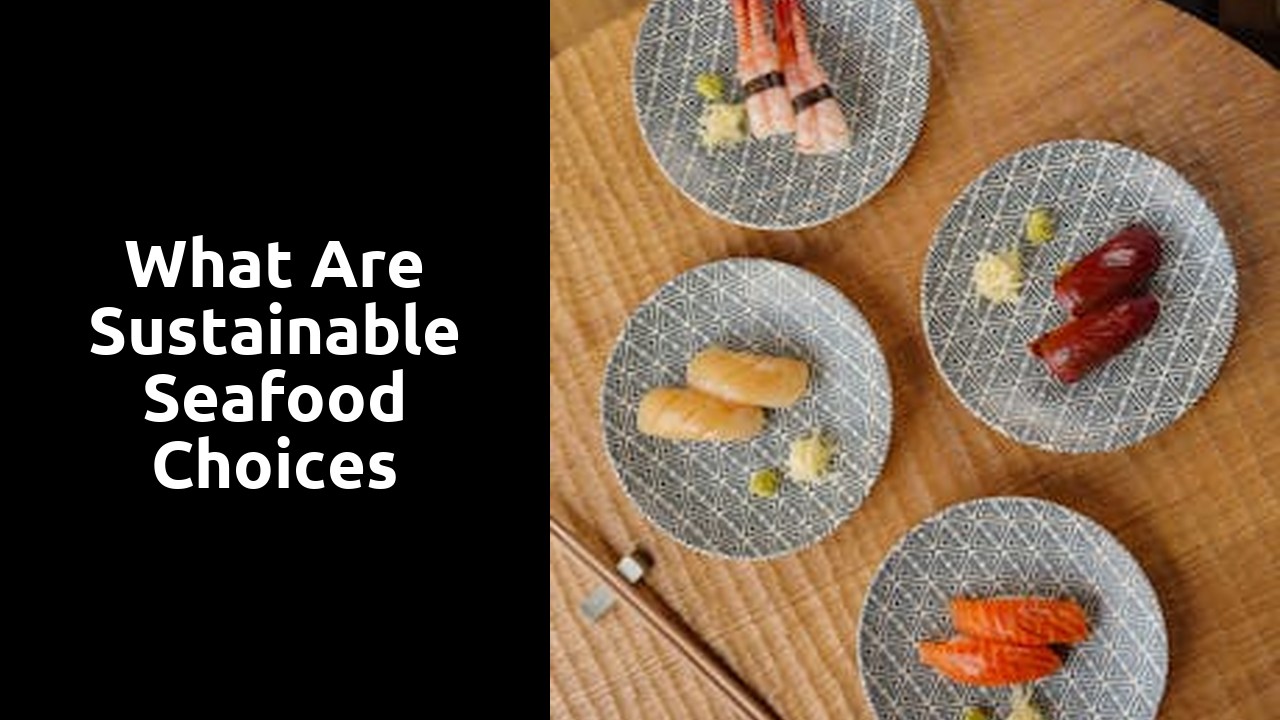What Are Sustainable Seafood Choices

Top Sustainable Seafood Choices
When it comes to making sustainable seafood choices, opting for species that are abundant in the ocean and responsibly harvested is crucial. Mackerel, for instance, is a fantastic choice due to its high population levels and fast reproduction rate. Additionally, mackerel is packed with omega-3 fatty acids, making it a nutritious option as well.
Another sustainable seafood choice is sardines. Sardines are small, fast-growing fish that have minimal impact on the environment when caught. They are also a rich source of essential nutrients like vitamin B12 and calcium. By selecting mackerel and sardines, you not only support sustainable fishing practices but also enjoy delicious and healthy meals.
Nutritional Benefits of Eating Sustainable Seafood
Eating sustainable seafood not only supports ethical fishing practices but also provides a range of nutritional benefits. Fish such as salmon, mackerel, and sardines are rich in omega-3 fatty acids, which are essential for overall brain and heart health. These fatty acids also play a crucial role in reducing inflammation in the body, which can help with conditions like arthritis and other inflammatory diseases. Furthermore, sustainable seafood is a great source of high-quality protein, vitamins, and minerals necessary for maintaining optimal health.
Including sustainable seafood in your diet can also boost your intake of essential nutrients like vitamin D, iodine, and selenium. Vitamin D is essential for bone health, while iodine is crucial for proper thyroid function. Selenium, found abundantly in seafood, acts as an antioxidant and supports the immune system. These nutrients are often lacking in many people's diets, making sustainable seafood a valuable addition to promote overall wellbeing and vitality.
Challenges in Promoting Sustainable Seafood
Promoting sustainable seafood faces several hurdles in gaining widespread consumer acceptance. Misleading labelling practices often leave consumers confused about the true origins and sustainability of the seafood they purchase. Lack of awareness regarding the environmental impacts of overfishing and unsustainable fishing methods further complicates the effort to encourage individuals to opt for sustainable seafood choices.
Moreover, the affordability of sustainable seafood can be a deterrent for many consumers, as these products tend to be priced higher than their non-sustainable counterparts. With economic considerations playing a significant role in consumer decision-making, making sustainable seafood more accessible and cost-effective is crucial in driving adoption. Collaborative efforts between governments, fisheries, retailers, and consumers are essential to address these challenges and pave the way for a more sustainable seafood industry.
Addressing Issues in the Seafood Supply Chain
Addressing issues in the seafood supply chain is crucial in promoting sustainable practices. Ensuring transparency and traceability throughout the supply chain is essential to combat illegal and unsustainable fishing practices. By implementing proper monitoring and verification systems, it becomes possible to track the journey of seafood from ocean to plate, holding stakeholders accountable for their impact on marine ecosystems.
Furthermore, promoting collaboration between governments, fishing industries, and consumers is vital in creating a more sustainable seafood industry. Establishing clear regulations and standards, coupled with consumer education campaigns, can help drive positive change in the way seafood is sourced and consumed. By working together towards a common goal of sustainability, we can protect our oceans and ensure a healthy seafood supply for future generations.
Sustainable Seafood Cooking Tips
When buying sustainable seafood, it's important to know how to prepare it properly to fully enjoy its delicate flavours and textures. A simple tip to remember is to avoid overcooking seafood as this can make it tough and dry. Instead, opt for quick cooking methods such as grilling, steaming, or pan-searing to preserve the natural juiciness of the fish or shellfish.
Seasoning sustainable seafood with herbs, citrus, and spices can elevate its taste without overpowering its natural essence. Fresh herbs like parsley, dill, and chives can add a burst of freshness to seafood dishes, while lemon, lime, or orange zest can provide a zesty kick. Experiment with different seasoning combinations to discover what complements the seafood flavour best and enhances your dining experience.
Delicious Recipes Using Sustainable Seafood Ingredients
For a hearty and sustainable meal, try making a delicious tuna and chickpea salad. Begin by mixing drained tinned tuna with cooked chickpeas, cherry tomatoes, cucumber, red onion, and fresh parsley in a bowl. Drizzle with a dressing of olive oil, lemon juice, salt, and pepper, and toss gently to combine. Serve this nutritious and flavoursome salad on a bed of mixed greens for a light and satisfying dish.
Another fantastic recipe using sustainable seafood ingredients is a coconut curry shrimp stir-fry. In a hot pan, sauté peeled and deveined prawns with diced bell peppers, snow peas, and sliced carrots. Add a mixture of coconut milk, red curry paste, and fish sauce to the pan and simmer until the sauce thickens. Garnish with fresh coriander and serve this aromatic and vibrant curry stir-fry over steamed rice for a delightful meal.
Related Links
Why Consumer Awareness is Important for Sustainable SeafoodWhat to Look for in Sustainable Salmon Certification
How to Cook Sustainable Salmon Fillets
Roundup: Best Sustainable Salmon Fillets Brands
Review: The Impact of Sustainable Salmon Fillets
10 Sustainable Seafood Choices for Ocean-friendly Eating
Why Sustainable Seafood Choices Matter